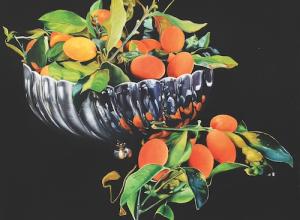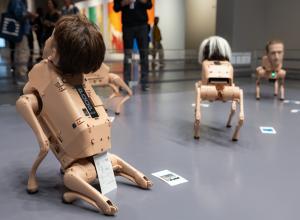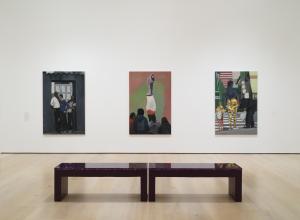
Suzanne Jackson, Installations at Whitney Biennial
Every two years, the Whitney Museum asks the question, “What does America look like and feel like to artists right now?”
Over the years, artists have considered political realities, American identity, neglected histories, and uncertain futures. This year, “Even Better Than the Real Thing”—the eighty-first edition of the Whitney Biennial, which is the longest-running survey of contemporary art in the United States—features seventy-one artists and collectives facing today’s most pressing issues.
Co-organized by two Whitney curators, Chrissie Iles and Meg Onli, the Biennial presents the efforts of contemporary artists working across a variety of media and disciplines, representing advanced ideas of American art.
“The Biennial is an engine that powers the Whitney forward, by introducing new artists and ideas to our community and beyond. It is both what we do and who we are,” said Scott Rothkopf, Alice Pratt Brown Director at the Whitney Museum.
Surveying the art and artists of this current Whitney Biennial, which opens to the public on March 20 and runs through August 11, Art & Object has picked 10 artists who we believe best illustrate this moment in time and the ideas and art that are most pertinent to it.

Arguably the most compelling work in this year’s Biennial, Sir Isaac Julien’s immersive, five-screen film installation, Once Again . . . (Statues Never Die), examines the relationship between Alain Locke, a Harlem Renaissance philosopher and Albert C. Barnes, an entrepreneurial chemist, art collector and champion of African culture. A contemporary master of the mediums of film, photography, and installation art, the London-born, British artist employed seasoned actors in his lifelike film and related photographs—staged in referential settings, including the Pitt Rivers Museum at the University of Oxford, where Locke was the first African American Rhodes Scholar in 1907, and the Barnes Collection in Philadelphia—to question what it means to interpret Black art and how such interpretations impact archival memory.
Image caption: Isaac Julien, Once Again… (Statues Never Die), 2022. Five-channel 4K video and 35mm film transferred to video, black-and-white, 9.2 surround sound; 31:32 min. Commissioned by Barnes Foundation, Philadelphia, and Ford Foundation, New York; co-commissioned by Sharjah Art Foundation. Courtesy the artist. Photo: Paul Laster

A mixed-media artist best known for her androgynist clay figures adorned with found and manufactured objects, Rose B. Simpson’s Daughters: Reverence sculptures stand at four corners of a platform looking at one another. Drawn together by intersecting red lines on the base, the defiant daughters form a potent pack of individuals who come from different tribes yet stand together as a unified group. Hand-built, life-size ceramic figures embellished with symbolic objects and indigenous Pueblo motifs by the New Mexico-born and based artist, the ritualistically decorated characters reference family, ancestry, gender, and marginality while standing tall in the face of societal restraints. Connecting the past and the present through clay (a medium used by her artist mother and great-grandmother), Simpson expresses power and strength, experience and identity with her imaginative handling of traditional materials.
Image caption: Rose B. Simpson, Daughters: Reverence (Daughter 2), 2023. Ceramic, steel, grout, twine, pine, and hide, 91 1/2 x 24 x 14 in. (232.4 x 61 x 35.6 cm). Tia Collection, Santa Fe, NM. and Daughters: Reverence (Daughter 1), 2023. Ceramic, steel, twine, and hide, 82 x 23 x 18 in. (208.3 x 58.4 x 45.7 cm). Collection of Charlotte and Herbert S. Wagner III. Photo: Paul Laster

A visual artist, poet, dancer, educator, and theatre designer, Suzanne Jackson’s works experimentally across a variety of mediums. For her Biennial room full of raw, suspended, colorful paintings, made between 2017 and 2023, the 90-year-old St. Louis-born, Savannah-based artist slowly constructed layers of acrylic, gel medium, found fabrics, detritus, and upcycled objects to make paintings in an inventive way. Taking painting off the canvas—and, in many cases, off the walls— Jackson mixes vibrant and muddied colors with bits of daily life and gives each piece a unique shape, look, and attitude. Abstract, yet loaded with reality, her eye-catching paintings dynamically reveal every moment of their making on their visceral, transparent skins.
Image caption: Suzanne Jackson, Installation view of Singin’, in Sweetcake’s Storm, 2017; Palimpsest Grit, 2022-23; Red over morning sea, 2021; deepest ocean, what we do not know, we might see?, 2021; and Rag-to-Wobble, 2020. Mixed media, including acrylic, acrylic gel medium, acrylic, detritus, cotton paint cloth, vintage dress hangers, buckram/crinoline, shredded mail, deer netting, textile pieces, canvas, graphite, aluminum, raw silk, shredded mail, twine, string, wood, braided string, mesh, wood, curtain lace, produce bag netting, nylon curtain mesh, extra coarse acrylic garnet gel medium, pistachio shells, and D-rings, Dimensions variable. Collection of the artist; courtesy Ortuzar Projects, New York. Photo: Paul Laster

A painter working across multiple mediums to explore the connection between ecology, infrastructure, and architecture, Torkwase Dyson combines concepts about the site and built environment with nature and culture under the umbrella of environmentalism. Employing such specific abstract shapes as water tables, boats, and oil rigs and mixing expressive drips, washes, and gestures in her paintings, she makes minimalistic yet expressive works with a graphic black-and-white or purely black palette, as seen in her smaller works in the show. On the museum outdoor terrace, however, the Chicago-born, Beacon-based artist fuses wood, steel, black granite, basalt, graphite, and acrylic paint to strikingly construct a monastic playground, where visitors can experience her art in a tactile, free-and-easy way.
Image caption: Torkwase Dyson, Liquid Shadows, Solid Dreams (A Monastic Playground), 2024. Wood, steel, absolute black granite, basalt, graphite, and acrylic. Collection of the artist; courtesy GRAY and Pace Gallery. Photo: Paul Laster

Using his body as the point of departure for a selection of four abstract sculptures and a hidden installation within the walls of the museum, Jes Fan created 3D-printed, organic artworks from CAT scans of his knee, hip muscles, vertebrae, and stomach mixed with hand-blown glass elements that surreally resemble internal organs. The Canadian-born, Brooklyn and Hong Kong-based artist’s Cross Section (Right Leg Muscle III) wall sculpture depicts a twisting shelf-like structure with a modeled surface, which recalls the ambiance of a cave with holes for letting in moments of light and mouth-like pockets for strange creatures to burrow. Although the two wall works and freestanding sculpture in the center of the room pack a powerful punch, his Gut installation—seen through wound-like slits in the wall—makes the artist’s sensual mix of materials seem all the more real.
Image caption: Jes Fan, Cross Section (Right Leg Muscle III), 2023. Polylactic acid (PLA) filaments, fiberglass, resin, pigment, and glass, 19 x 31 x 13 in. (48.26 x 78.74 x 33.02 cm). Commissioned by M+, Hong Kong. Collection of the artist; courtesy Andrew Kreps Gallery, New York, and Empty Gallery, Hong Kong. Photo: Paul Laster

An artist and musician of Peruvian and Irish-American descent, Eamon Ore-Giron draws from Andean folklore for the three, standout, large-scale paintings from his Talking Shit series in the show. Referencing deities from ancient Peruvian and Mexican cultures, the Tucson-born, Los Angeles-based artist brings his cultural past into present times with a modernist form of abstraction married to pre-Columbian Mesoamerican motifs. In his persuasive painting Talking Shit with My Jaguar Face, Ore-Giron reimagines a jaguar, which was the largest cat in Central and South America and a feared, aggressive predator, as a revered sphinx, ready to go to battle, while portrayed in a playful, graphic—almost product or logo design—sort of way.
Image caption: Eamon Ore-Giron, Talking Shit with My Jaguar Face, 2024. Mineral paint and vinyl paint on canvas, 72 x 72 in. (182.9 x 182.9 cm). Collection of the artist; courtesy James Cohan, New York. Photo: Paul Laster

Best known for deep frying decommissioned American flags that once flew at the Capitol, Kiyan Williams is fearless when it comes to subverting sacred cultural symbols. Their outdoor sculpture Ruins of Empire II or The Earth Swallows the Master’s House reproduces the north facade of the White House from a reflective, metallic soil, which Williams envisioned as a blurry mirror. Leaning on its side and sinking into the earth like a scene out of a futuristic film, it hauntingly flies an upside-down American flag, blowing in the breeze on the museum’s terrace. Nearby, the Newark-born, Brooklyn-based artist has fashioned a trans-gender protester out of cast, polished aluminum. Bearing a sign that reads POWER TO THE PEOPLE, the sculptural figure—titled Statue of Freedom (Marsha P. Johnson), after the celebrated, deceased American gay liberation activist and self-identified drag queen—gazes upon the government ruins with a degree of satisfaction, while casually holding a cigarette in hand.
Image caption: Kiyan Williams, Statue of Freedom (Marsha P. Johnson), 2024. Aluminum, Dimensions TBC and Ruins of Empire II or The Earth Swallows the Master’s House, 2024. Earth, steel, and binder, Dimensions TBC. Collection of the artist. Photo: Paul Laster

Studying anthropology at Yale University before returning to school to earn an MFA in New Genres from UCLA, Nikita Gale’s work explores ways that silence, noise, and visibility function as political stances and conditions. Born in Anchorage and based in Los Angeles, Gale’s practice focuses on the relationship between materials, power, and attention—with an emphasis on who or what is seen, heard, recorded, remembered, and believed. Her performative installation in the Biennial, TEMPO RUBATO (STOLEN TIME), presents a player piano performing a score, but rather than hearing the music the audience gets just the sound of a bodyless figure teasing the piano keys. Working with a lighting technician, Gale added the drama of a real recital, leaving the viewer to decide when it’s best to applaud.
Image caption: Nikita Gale, TEMPO RUBATO (STOLEN TIME), 2023–24. Modified player piano, audio, and LED lighting system. Collection of the artist; courtesy Commonwealth and Council, Los Angeles and Mexico City; Petzel, New York; Emalin, London; and 56 Henry, New York. Fabrication: Lindeblad Pianos. Sound design: Daniel Neumann. Lighting design: Josephine Wang. Photo: Paul Laster

Marrying experimental black aesthetics with influences of Minimalism and Abstract Expressionist painting, Mary Lovelace O’Neal has been creating lively large-scale canvases for more than 60 years. Greatly involved with the civil rights movement on a political level, she didn’t shift her aesthetic style of painting to make representational works that would illustrate the struggle, rather she believed that abstraction was able to reveal an equal side of Black life. Returning to the attention of critics, curators, gallerists, and collectors with a 2020 New York solo show—her first in the city since 1993—the Mississippi-born, California and Mexico-based artist now commands three walls in the Biennial with paintings like Twelve Thirty-Four (from the Doctor Alcocer's Corsets For Horses series), which wildly depicts an expressively painted, white-corseted-horse charging across a black, Minimalist landscape with bold determination.
Image caption: Mary Lovelace O’Neal, Twelve Thirty-Four (from the Doctor Alcocer'sCorsets For Horses series), 2023. Acrylic and oil pastel on canvas, 84 x 240 in. (213.4 x 609.6 cm). Collection of the artist; courtesy KarenJenkins-Johnson. Photo: Paul Laster

A standout artist working with photography and sculptural reliefs, B. Ingrid Olson makes photos of fragmented views of her body intermixed with elements of interiors, props, shadows, mirror reflections, and disjointed borders, while her reliefs suggest containers for specific body parts. Putting the two parts in dialogue for a wall installation of pictures and sculptures spread across two of the museum’s walls, the Denver-born, Chicago-based artist has created a formal display of works to catch the viewer’s curiosity and get them engaged. The body is absent in her sculptural Indexes and obscured in her Dura Pictures, making viewers wonder whether Olson wants to almost disappear into her artwork—leaving her audience with only the thoughts she had when making it.
Image caption: B. Ingrid Olson, Coming in with your back turned, 2021-22. Inkjet print and UV printed matboard in powder-coated aluminum frame, 29 x 19.25 x 1.25 in. (73.7 x 48.8 x 3.2 cm) and Proto Coda, Index (detail), 2016-22. Inkjet print and UV-printed matboard in powder-coated aluminum frame; MDF, Polycrylic, plywood, glue, vinyl, eggshell, aluminum, and latex paint, 30 parts, installation variable. Courtesy the artist and i8 Gallery, Reykjavik. Photo: Paul Laster
Paul Laster
Paul Laster is a writer, editor, curator, advisor, artist, and lecturer. New York Desk Editor for ArtAsiaPacific, Laster is also a Contributing Editor at Raw Vision and Whitehot Magazine of Contemporary Art and a contributing writer for Art & Object, Galerie, Artforum, Artsy, Ocula, Family Style, Sculpture, and Conceptual Fine Arts. Formerly the Founding Editor of Artkrush, he began The Daily Beast’s art section and was Art Editor at Russell Simmons’ OneWorld Magazine. Laster has also been a Curatorial Advisor for Intersect Art & Design and Unique Design, as well as an Adjunct Curator at P.S.1 Contemporary Art Center, now MoMA PS1.























